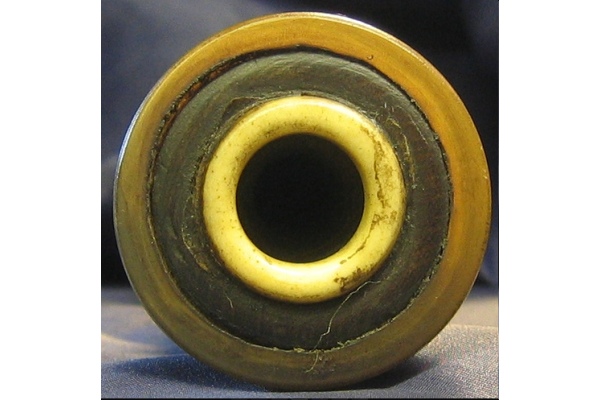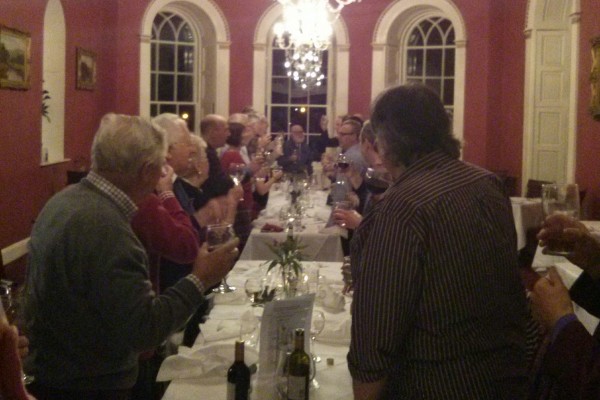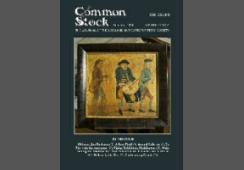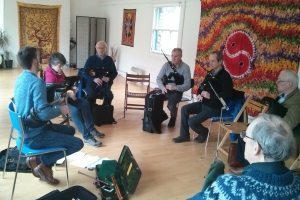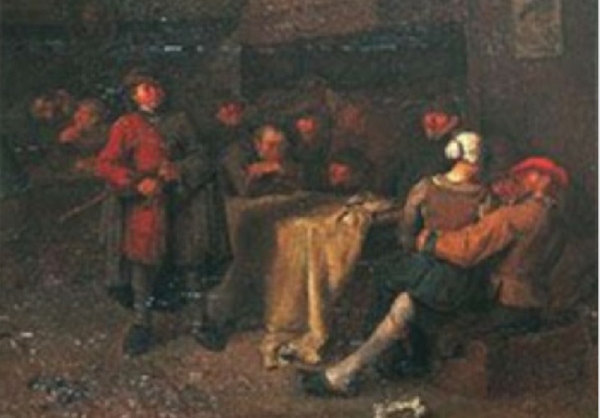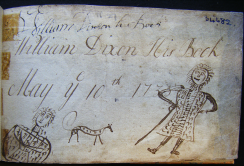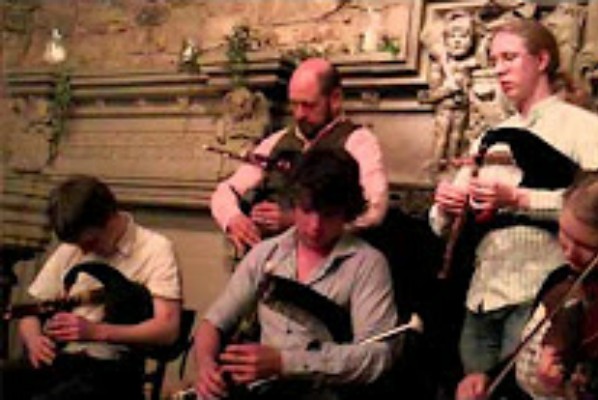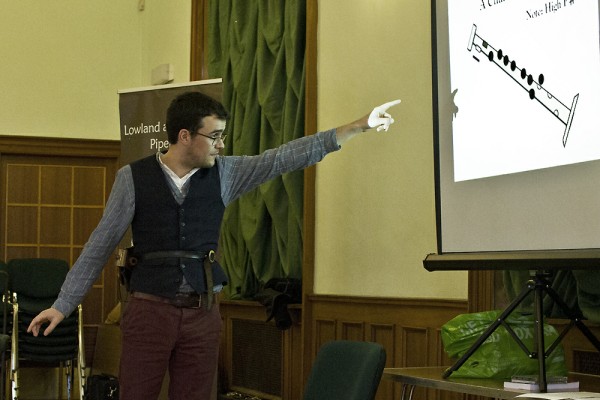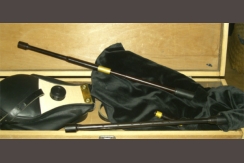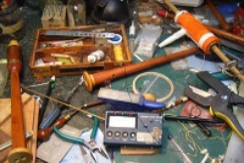The first of the day’s speakers told of his life in piping and his old set of pipes
When I was nine years old, in 1958, my father Duncan Reid agreed to my request to be trained as a piper. He himself had taken some stabs at piping in his youth but was interrupted by the outbreak of WWII and he never really reached proficiency. So on a visit to his mother's house in the hamlet of Tara, Ontario, (his father had died the year after I was born) we opened up a storage cupboard in her attic where, stashed behind various old shinty sticks and fishing rods, was a case containing an old practice chanter and an old, dried up set of Highland pipes (Thow c. 1880); the one which my father had attempted to master twenty years before. Beside that case was a box which contained a battered metal clarinet, a music stand and remnants of another bagpipe covered with dead spiders. This one had two tenor drones in a common stock; a third socket in the stock was corked and presumably had once contained a bass drone which was missing. There were no bellows, but a very short fixture stuck in the inflation stock which could only have been a nozzle for bellows.

As for the history of these old pipes, no one knew for certain. Grandmother (a MacDonald whose family were from Arisaig and descended from the legendary Jacobite Ranald MacDonald of Borrodale) only knew that this bagpipe came from her late husband's side of the family; the Reids. When and where they got it is anyone's guess. There were two large family bibles in the house, one from the MacDonald side and the other from the Reids, each dating from the early 19th century and containing detailed lists of births, marriages and deaths at the back. So they could have been acquired by my grandfather Dr Duncan Reid MD 1885 - 1949, or his father Dr Robert Reid MD 1848 - 1935, or his father Rev Adam Reid 1808 - 1878, or his father John Reid 1775 - 1854, who was a weavers' agent. The overriding characteristic of this line of Reids is that they were all professionals and quite mobile, working or studying at times in such varied places as Paisley, Perthshire, Boston, Vienna, Québec, Berlin; all in the 19th and early 20th centuries. Whether or not they actually played this bagpipe or how long it had been in the family no one knew. It could have been a treasured heirloom that had been purchased long ago. But it seems to me just as possible that one of them picked this bagpipe up somewhere as a curio or perhaps it was a gift or payment from a patient to one of the doctors in the family or from a parishioner to the Reverend Adam or from a weaver to his agent.
We took them home along with the other pipes and the practice chanter on which I started my lessons. Then in around 1961 my father got a copy of the newly published book "Bagpipes" by Anthony Baines (Oxford University Press 1960) which had details and pictures of bagpipes from around Europe and the Near East. I was intrigued by all of these and determined to find and collect as many as I could (something which I largely accomplished by my mid-twenties). Among the various bagpipe types was No 29 Lowland Pipe, Scotland. The incomplete set that we had was obviously remnants of one of these "Lowland Scottish" bagpipes. So, with my father's help I made an attempt to get them in playing order as a school project, making a new bag and reeds with advice from my piping teacher and sawing the handles off of an old household bellows to inflate it. It barely worked but it had potential.
In 1965, at the age of 16, I made a lengthy pilgrimage around the Highlands, travelling alone on foot and visiting tradition-bearers who could teach me songs, tales and tunes. Sometimes I stayed with them, other times in a tent, often in youth hostels, which were a rich source of folk songs and tales; not only from fellow hostellers but from local folk who would come around in the evenings in the absence of a pub. At the end of that summer when I turned 17 I took my Lowland bagpipe into J & R Glen, Bagpipe Makers, on the Lawnmarket in Edinburgh. I spent a considerable amount of time there consorting with Andrew Ross Jr and his father Andrew Ross Sr who looked over these mysterious old Lowland pipes in detail and made further adjustments to get them working more easily, though they still lacked a bass drone. It was Andrew Ross Sr who pointed out that the maker's stamp on the drone stock was that of William Mark, an early 19th century maker in Aberdeen. He also told me that they were made from boxwood except for the chanter which was of laburnum. The mounts were of ox-horn, bone and "sea ivory" (whale's tooth or walrus tusk). The wood was stained black with printer's ink. Despite their incomplete state, I played them in some of Edinburgh's folk music coffee houses: The Stockpot and The Laigh (both on Hanover Street) and The Partizan on the West Bow.
 The stamp of W Mark appears twice on the drone-stock but is very worn and difficult to see
The stamp of W Mark appears twice on the drone-stock but is very worn and difficult to see
Over the next five years I played them in various coffee houses and festivals along the West Coast of America: in Vancouver, Seattle, San Francisco and Los Angeles. In early 1966 I had hooked up with a young Tlingit Indian called Greg who played fiddle in duets with my pipes. He chummed me in my travels along the Pacific coast. My poorly constructed bellows became too faulty to repair so I substituted a blow pipe, still playing them without a bass drone. I also made two journeys through the Balkans and east-central Europe ('68 and '70) to fulfil my quest to find other European folk bagpipes: Serbia, Macedonia, Bulgaria, Croatia, Slovakia and Czechia. I used my school-learned Russian to get by at first, soon picking up the rudiments of other Slavic languages along the way.
At an early stage of this five-year odyssey, in the autumn of 1966, I met a fellow devotee of European bagpipes at The Troubador Los Angeles; Robert "Bob" Donovan Thomas, a Californian of Welsh parentage who played in the Renaissance Faire with his band The Golden Toad. I played there myself, sometimes along with them, usually using the full Highland pipes. After my permanent return to Scotland in 1970, Bob Thomas turned up at my door having just spent a year in a California state prison; the Golden Toad had been arrested when playing at a huge party held by Owsley Stanley who was the world's leading producer of LSD at the time (and also sound manager of The Grateful Dead, whose iconic logo was designed by Bob Thomas). Because he had had no criminal record, Bob was kept in a low security "rehabilitation" prison which had an excellent workshop full of woodworking tools and equipment, as well as an abundant supply of wood. So he spent the entire year focused on learning the craft of bagpipe making; paid for by the State of California. Once released, he came over to Europe to collect more bagpipes, working for a while as an instrument restorer for antique dealer Tony Bingham in London. He undertook a massive renovation of my old Lowland pipes: making a new bass drone and restoring the drone stock by inserting metal tubing. Unfortunately, the common drone stock had shrunk unevenly so that the tenor drones collided with one another, making them difficult to tune. So I usually played with just the bass and one tenor after that. But he replaced any missing or broken ferrules with new ones of horn (most of the originals were of sea-ivory or bone) and got the pipes so that they played much more smoothly. Later, our mutual friend Sean Folsom - another devotee of the Baines book of Bagpipes - located an old bellows for me and I travelled over to a small town in Lanarkshire to pick it up. I cannot remember exactly where it was, but it was the most unlikely place to find an antique bagpipe bellows.
So my Lowland pipes were at last complete and playable. Bob and I both travelled around the Borders and played in open spaces in an effort to learn more about their playing style and repertoire. He managed to copy out numerous tunes by hand in local libraries. In 1974 we met up with Jimmy Eaton, a piper who stayed just around the corner from me in Edinburgh. He managed to obtain a set of Lowland pipes in Glasgow and the three of us formed The Lowland Pipers Society. In 1975 I stayed for several months in Italy, busking in Piazzas with my bellows pipes. Bob Thomas came down and joined me for a few weeks and we travelled around Italy busking together and seeking out Italian folk bagpipes and their players.

A young James in Italy
Later that year I also played them in a talk I gave at the Royal Northern College of Music. Back in Edinburgh, I played my Lowland pipes now and then in the Traverse Theatre Club in the Grassmarket and in folk-music pubs such as The Fiddlers Arms, Sandy Bell's and The West End Hotel. They were right on A and so fiddlers such as Johnny Cunningham, Adam Jack, Derrick Hoy and others sometimes played along with me. Hamish Henderson frequented those venues and he told me what he knew of Lowland pipers such as Francie Markus. Then in 1976 the director of the Royal Lyceum Theatre staged a new play by Hector Macmillan called "The Royal Visit" which took an oblique look at the visit of George IV to Edinburgh in 1822. Having seen me playing in the Traverse, the director (Stephen MacDonald) asked me if I would play in this production. So I made myself a pair of knee britches, put on an old broad Scots bonnet and a shepherd's plaid and played on the stage of the Lyceum Theatre along with the cast and the band "The McCalmans". This brought the instrument to wider public attention, further promoted by a spot I did on television, which was filmed at the base of Arthur's Seat.
In 1979 I played them in the Edinburgh Folk Festival, accompanied by a cellist. Sean Folsom came over from California for a short visit during the late 1970s and added his membership to the Lowland Pipers Society as it was.
During the run of The Royal Visit at the Lyceum, an elderly gentleman came to the stage door asking if he could speak with me. His name was Cedric Clarke. He had seen me playing my Lowland pipes on television and travelled over from his home in Dirleton to introduce himself. He too played Lowland bellows pipes and he duly joined The Lowland Pipers Society. He often came to visit me over the years after that, sharing his knowledge of Lowland folk customs, tunes and dances. He was a member of the Covenanters Church and always said a quiet grace before eating any morsel of food.

Then in 1980 due to financial pressures I went abroad to work, ending up with a job in the archives of Harvard University's International Legal Studies Department. While there I played my old Lowland pipes frequently in various venues and shows, eventually in the Scottish dance band "Paddledoo" along with fiddler Ed Pearlman and vocalist Talitha Nelson (now Mackenzie). I played them in Europe again at folklore festivals and then in Japan in 1985. Returning to Scotland in 1986 was my first opportunity to play them at an event hosted by the Lowland & Borders Pipers Society, which included Jimmy Eaton and Cedric Clarke among its members. They both regarded the LBPS as a continuation of our Lowland Pipers Society from 1974. But that is another matter. In any case, I entered as a competitor in the Open competition as I had never competed before in a LBPS event. I played my old W. Mark pipes, using what I had learned of the simple gracing which characterised the Lowland piping style. I chose a tune I had learned from Northumbrian piper David Sweetman which was entitled "The Skye Crofters". I assumed that this was composed by a Lowland or Borders player and that it was a commemoration of the Skye crofters' insurrection in 1883. There is an entirely different Highland pipe tune of the same name, but this one was structured in more of a Lowland mode.
In the late 1980s I formed a group called "Drumalban" to present old Scottish folk dances with traditional songs and instruments. We did this with great care to authenticity in every detail, using what I had learned from old-timers back in the '60s for our dancing technique and singing style. For some of our Lowland sets I played my old Mark Lowland pipes along with other musicians, including the young Martyn Bennett. We performed at various venues around Scotland and at several festivals in Europe for around 20 years. But no adequate funding was available to support a group of this nature and I was in no position to provide for it. So I gradually turned my attention to other pursuits, particularly in eastern Europe. The Lowland pipes which I played so much during the 1960s through the 1990s ended up back in a box to await rediscovery by someone in a future generation. Or perhaps sooner if someone would inspire me to get them playing again.

James in full flow
